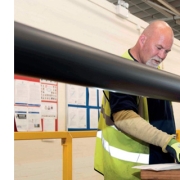Replacing drainage stacks in larger multiple occupancy buildings can be a challenging task. Not only could pipe fittings and connection sizes be outdated, but older buildings can also have any number of hidden surprises in store once work starts. Plus, dealing with all this must be balanced with the need to minimise disruption caused to residents. Dean Pearse, Project Manager at Polypipe Building Services explains how they use offsite manufacturing methods to help overcome these issues.
Traditional methods
In multiple occupancy buildings the traditional approach of assembling loose drainage stack components on site can mean a significant level of disruption, as this typically means a period where residents are unable to use their sinks, toilets and other facilities. Added to this is that the older a building is, the more likely that what’s found on site differs to the original plans – if these plans are even still around. Bathrooms may have been moved or reconfigured, additional appliances may have needed extra drainage. This adds up to a range of challenges unique to each project, and the potential for time-consuming surprises if a traditional approach is taken and they are dealt with as they are encountered.
This was the case at two 11-storey tower blocks owned by Fortem and Birmingham City Council where our Advantage service carried out a complete stack replacement. Moreover, there were elderly and vulnerable residents in situ which meant installation safety, speed and efficiency was essential. It was therefore important that we tried to avoid the cutting and welding associated with on-site assembly so that disruption was kept to a minimum.
A better solution
 It was recognised that prefabricating the drainage system would offer the most effective way to both minimise disruption and to work around the known changes to the layout of the tower blocks since they were built. This was completed by our Advantage team, who provided a full design and comprehensive prefabricated system that meant much less work on site cutting and welding pipework.
It was recognised that prefabricating the drainage system would offer the most effective way to both minimise disruption and to work around the known changes to the layout of the tower blocks since they were built. This was completed by our Advantage team, who provided a full design and comprehensive prefabricated system that meant much less work on site cutting and welding pipework.
Initially this urgent drainage replacement had seemed straightforward to the installer given both blocks appeared very similar in layout on the original plans. However, as their team moved in to begin work on one of the blocks it became apparent that in this block there was an additional stack serving the ground floor apartments which was not on the original plans. Digging through the floors of apartments on this level to discover where this stack ran wasn’t an option, so a bespoke solution was needed which could connect the existing iron stack to the new one.
In this instance, having the system designed by us offered a further benefit in that our team was able to step in and produce bespoke pipes and fittings to accommodate the unexpected layout found on site. These were then fabricated within a very short time frame to ensure the programme of works on site wasn’t delayed.
Ease of installation
HDPE is durable and flexible enough to accommodate different diameters in pipework and height which is essential when older pipework may no longer match standard loose parts which would then need more work to address using more time on site.
HDPE is also lightweight making it easier to install and offers advantages in how it can be prefabricated as 3D printed jigs and mirror-welding offsite means connection angles can be bespoke engineered to tight tolerances to accommodate a range of fittings. In this case it ensured a safer and better-quality installation while still meeting the tight timeframe for the project.
With temporary mechanical connections at the top and bottom Terrain FUZE drainage stacks can also be made live quickly allowing residents to use their facilities, then all the branches can be capped and connected later. With this project the inlet position needed bespoke connections into the stack which can elbow differently, and the customer relied on the Advantage team to put them in the right place. The solution in this case was for them to be fabricated into two sections so they could be twisted into exactly the right position. Working with HDPE also means the pipework can be futureproofed with extra fittings for future installations as spigots with welded-on end caps can be left ready for additional appliances in the future. Working with a manufacturer who can offer a bespoke design and prefabrication service means that live stack replacement in RMI projects like this can be completed quicker and any unexpected surprises within the drainage system are addressed within the design stage rather than in real-time at greater cost in time, materials, and disruption to residents. Offsite methods of construction also reduce the amount of skilled labour needed by contractors on site, and by reducing this burden we can help reduce supply chain issues, including labour timescales, that can impact on their project delivery.
For more information about the prefabrication options and Advantage
Service from Polypipe Building Services
call 01622 795200
OR CLICK HERE TO VISIT THE WEBSITE



